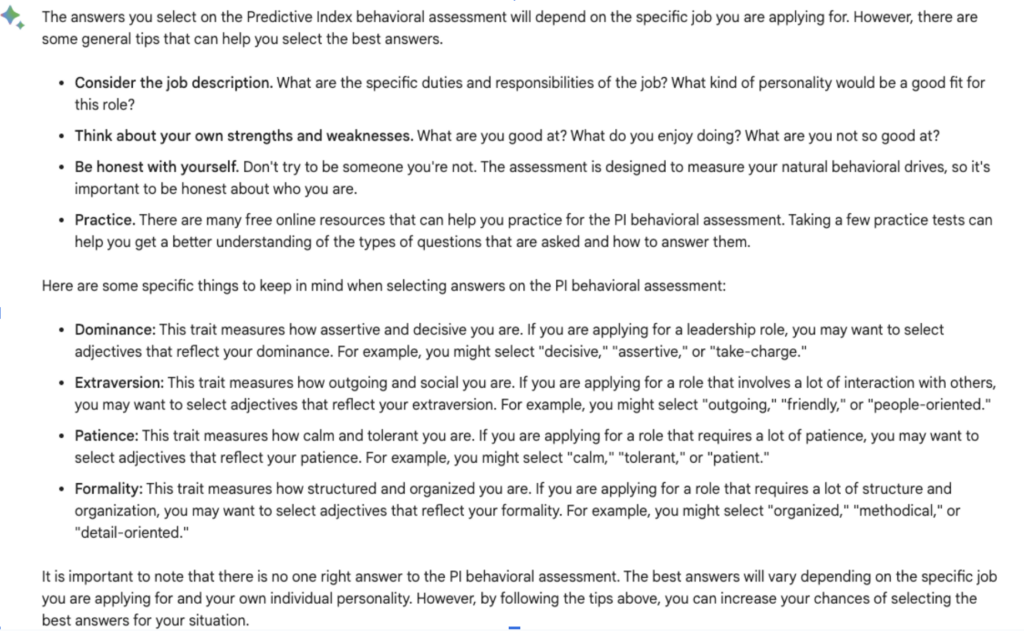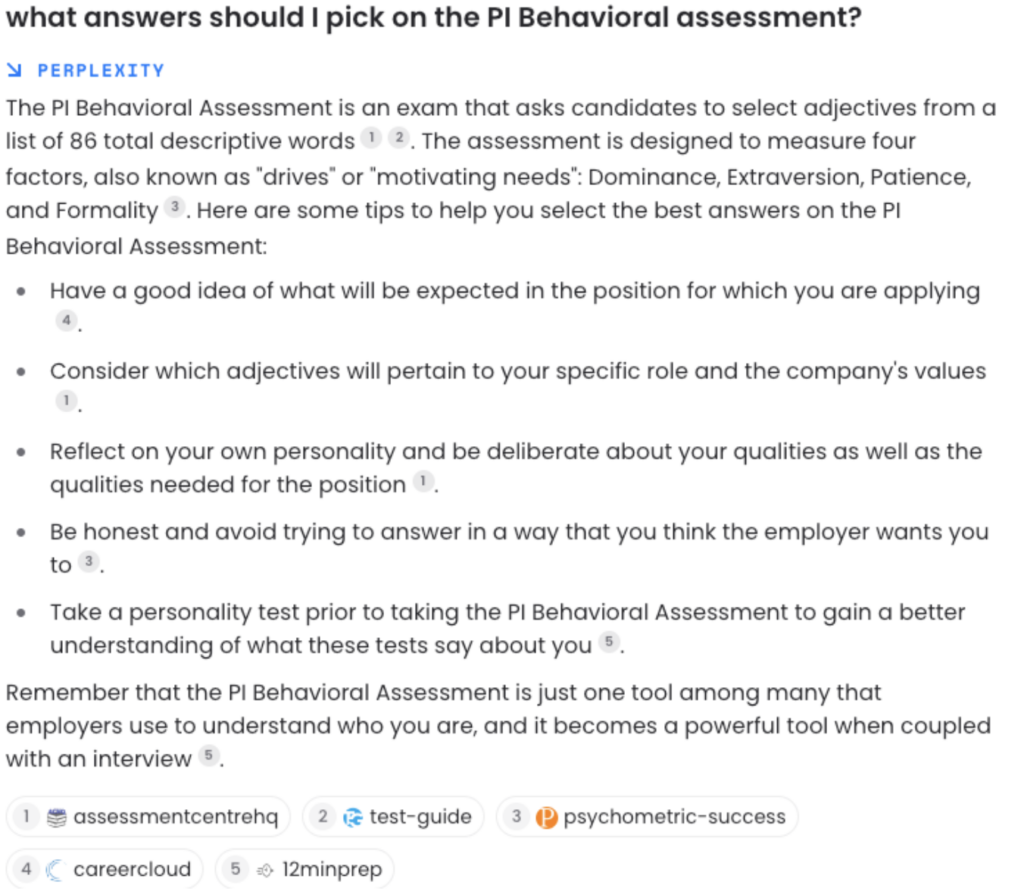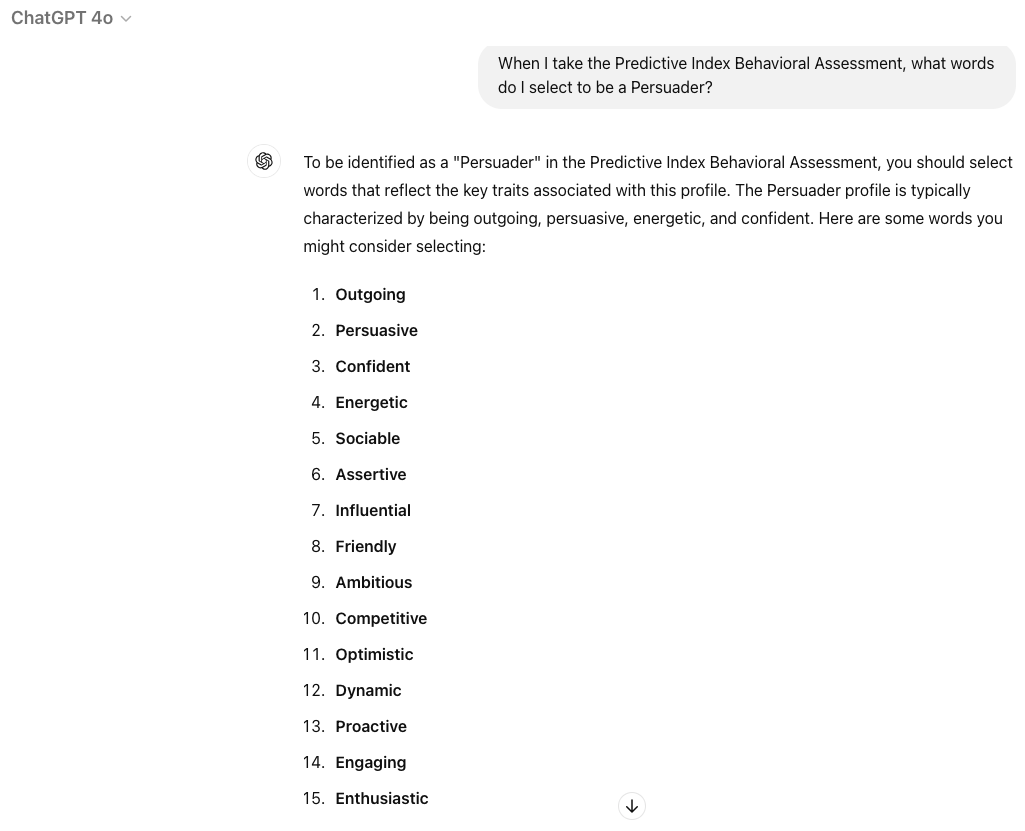
Is Predictive Index Artificial Intelligence?
With a continuous trend of technology in the workplace and equal concerns about equality, safety, and validity of tech tools, many questions have surfaced regarding use of AI in the workplace, with the EU generating the world’s first set of regulations regarding Artificial Intelligence. This article will address Predictive Index® tools and assessments as it relates to technology in the workplace.
Okay, but first, what even is AI?
Artificial Intelligence (AI) is a field of computer science that focuses on building smart machines capable of performing tasks that typically require human intelligence. AI is a machine’s ability to perform cognitive functions that we associate with human minds, such as perceiving, reasoning, learning, interacting with an environment, problem-solving, and even exercising creativity. Additionally, what separates AI from human minds is that AI can only draw from pre existing sources (or their defined database) and can’t generate completely new and unique content.
Is the Predictive Index AI?
In short, no. The Predictive Index assessments and reports use algorithms based on years of data accumulated by the science team. The assessment input results in a fixed set of data that is translated into actionable steps in your tools and reports. Now, the different reports (Personal Development Chart, Management Strategy Guide, and even Team Discovery tool) provide customized insights that are configured based on the makeup of the PI Behavioral Assessment, but there’s no machine learning involved.
What about PI Perform?
PI Perform is is a new tool that is an all-in-one platform for managing meetings, feedback, goals, and employee recognition—all while incorporating the same behavioral insights. This performance management system does incorporate an AI writing assistant for the purpose of quickly drafting feedback, recommending common goals for development, and suggesting action items. However, the behavioral data incorporated uses the same closed-system algorithm to provide scientifically-backed data on employee strengths and motivations.
Why This Matters
The tools you use need to be safe and valid for the workplace. The European Union has recently passed the EU Artificial Intelligence Act which is the world’s first set of regulations concerning AI. The EU AI Act aims to ensure better conditions for the development and use of AI technology, while also protecting users.
The Key
AI refers to systems that imitate human intelligence, learn from data, and can make decisions independently. Man-made computer algorithms, on the other hand, are fixed sequences of instructions that solve specific problems and lack the ability to learn or adapt.
PI is Safe for Work: PI treats validation as an ongoing process. PI scientists are continuously adding to a portfolio of validation research, which currently includes more than 350 validity studies.
PI’s assessments and recommended practices comply with:
- Uniform Guidelines for the Development and Use of Personnel Selection Procedures
- (1978)
- American Psychological Association (APA)
- Society for Industrial and Organizational Psychology (SIOP)
- International Test Commission (ITC)
In addition, the PI Behavioral Assessment™ and PI Cognitive Assessment™ are certified under the European Federation of Psychologists’ Association’s (EFPA) Test Review Model.
Can AI be used to cheat on the PI Behavioral Assessment?
Currently, no.
The PI Behavioral Assessment™ is designed for the human brain. In addition, there’s no “right” or “wrong” answers for the Behavioral Assessment. While the questions on the Behavioral Assessment (and the words you can select) are available with a quick Google Search (and even some articles on “how to prepare”), AI cannot currently predict the output for the PI Behavioral Assessment – we tested it! [Images below]. When asked to suggest answers for the Behavioral Assessment, most chatbots respond with either a statement about the PI Behavioral Assessment, or general knowledge about Drives and Factors from the PI website.


In testing Chat GPT-4, we asked for the answers to get a certain pattern result (Persuader, for example), and the chatbot answered confidently, however, the answer it provided did not match up to the actual Behavioral Assessment questions. The chat suggested 15 words you should consider selecting, but only six of the fifteen suggestions were on the assessment. Further, when only those six matched words were submitted, the results ended up as an Individualist (not, the Persuader, which was the goal).

In addition, even if a person was trying to “game” the assessment, or ask generative AI for the answers, the world wide web and chatbots don’t know the Job Target you’ve set for your roles and therefore can’t predict what the preferred outcome of the assessment even is.
Can AI be used to cheat on the PI Cognitive Assessment?
Again, no. For the PI Cognitive Assessment, the Predictive Index science teams continuously monitor for the ability to cheat, including if the test questions and answers are available on the web. The PI Cognitive assessment is timed—so any outside resource such as googling a math question or asking ChatGPT a verbal question would take time away from the test-taker, impacting their overall score. In addition, the PI Cognitive Assessment also uses some visual pattern questions that some AI chatbots don’t have the ability to read.
Our Recommendations
First, educate and communicate! Share how your organization uses PI internally and how you employ the data to improve both your candidate’s and your employees experiences.
Second, use Job Targets to increase validity of PI results for hiring and job matching. When you create a Job Target for a role, you can match candidate and employee behaviors to the role, which will allow you to interview and coach effectively.
In Summary: Predictive Index assessments do not use Artificial Intelligence
As AI continues to advance and grow in popularity, concerns about its equality, safety, and validity have arisen, leading to the introduction of regulations such as the EU Artificial Intelligence Act. However, it is important to differentiate between AI and tools like the Predictive Index (PI) assessments, which do not involve machine learning and instead rely on fixed algorithms based on accumulated data.
The safety and validity of PI tools have been addressed through ongoing validation processes and compliance with industry standards. Furthermore, attempts to cheat on the PI assessments using AI are currently ineffective due to the specific design of the assessments and the inability of AI chatbots to generate accurate responses. To maximize the effectiveness of PI and similar tools, organizations are encouraged to educate and communicate their usage internally and utilize Job Targets to enhance the validity of results for hiring and job matching purposes. Overall, while the concerns surrounding AI in the workplace are valid, the Predictive Index tools demonstrate a commitment to safety, validity, and ethical use.
Explore more: The effects of AI on Talent Optimization
This post was last updated on July 3, 2024.
Get Expert Advice on When and How to Use AI in People Operations
Without turning your workforce into robots.


